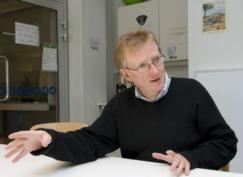Title(题目):Proton conducting ceramics for energy and chemicals
Reporter(报告人):Professor Truls Norby, University of Oslo,Norway
Time(时间):Mar 15th (Thursday) 9:00am(3月15日上午9:00)
Site(地点):A-260, Lee Shau Kee Building of Science and Technology(李兆基科技大楼A260会议室)
Inviter(邀请人):韩敏芳教授
Abstract:Proton-conducting ceramics such as Y-doped BaZrO3-based perovskites form basis for hydrogen-fueled proton ceramic fuel cells (PCFCs) and proton ceramic electrolyzers (PCEs) for steam. Like the PCFC benefits from running undiluted hydrogen with superior fuel utilization without circulation, the PCEs produce directly dry hydrogen at the balanced total pressure of the electrolyzer. The use of waste or renewable heat to generate and superheat the steam allows operation at high electrical efficiencies.
Operation at high steam pressures reduces p-type electronic conduction at the steam+oxygen electrode, and the use of novel mixed proton-electron conducting double perovskites as positive electrode lowers the overpotential and hence p-type electronic conductivity further, altogether yielding acceptable faradaic efficiencies of the electrolyzer.
Proton-conducting ceramics also offer unique opportunities for dehydrogenation of hydrocarbons including natural gas for different products, as suggested by Iwahara 3 decades ago. With materials and reactor design optimizations as well as process adaptions we now see emerging demonstrations of such use of proton-conducting ceramics for gas-to-liquid (GTL) conversion and for steam reforming to make hydrogen with carbon capture and storage (CCS).
Brief Biography:

Professor Truls Norby (b.1955) has his PhD from the University of Oslo (UiO) 1986, where he studied and worked with late prof. Per Kofstad.
Norby became professor at the Department of Chemistry 1994 and head of the Group for solid-state electrochemistry in 1997, a group which is part of the Centre for Materials Science and Nanotechnology (SMN) at UiO.
Norby works with thermodynamics and transport of defects in materials for solid-state fuel cells, electrolysers, gas separation membranes, sensors, and metal protection oxide layers. He specialises in protons in oxides and their use in high temperature proton conductors and hydrogen separation membranes. Recently, he also focuses on surface topics related to transport on surfaces and across interfaces (grain boundaries, electrodes) and on the semiconducting properties of oxides for uses in photoelectrochemistry and thermoelectrics.
He has published more than 220 journal papers, graduated 80 Master- and PhD-students, and is editor of Solid State Ionics. He is member of the Norwegian Academy of Science and Letters and other national academies. He has won the UiO Innovation Prize (2012) and the Norwegian Guldberg-Waage medal for chemistry.
He has founded companies NorECs AS (2001) which develops, manufactures, and sells test equipment and Protia AS (now CoorsTek Membrane Sciences AS) (2007) which develops energy conversion processes using proton conducting materials.